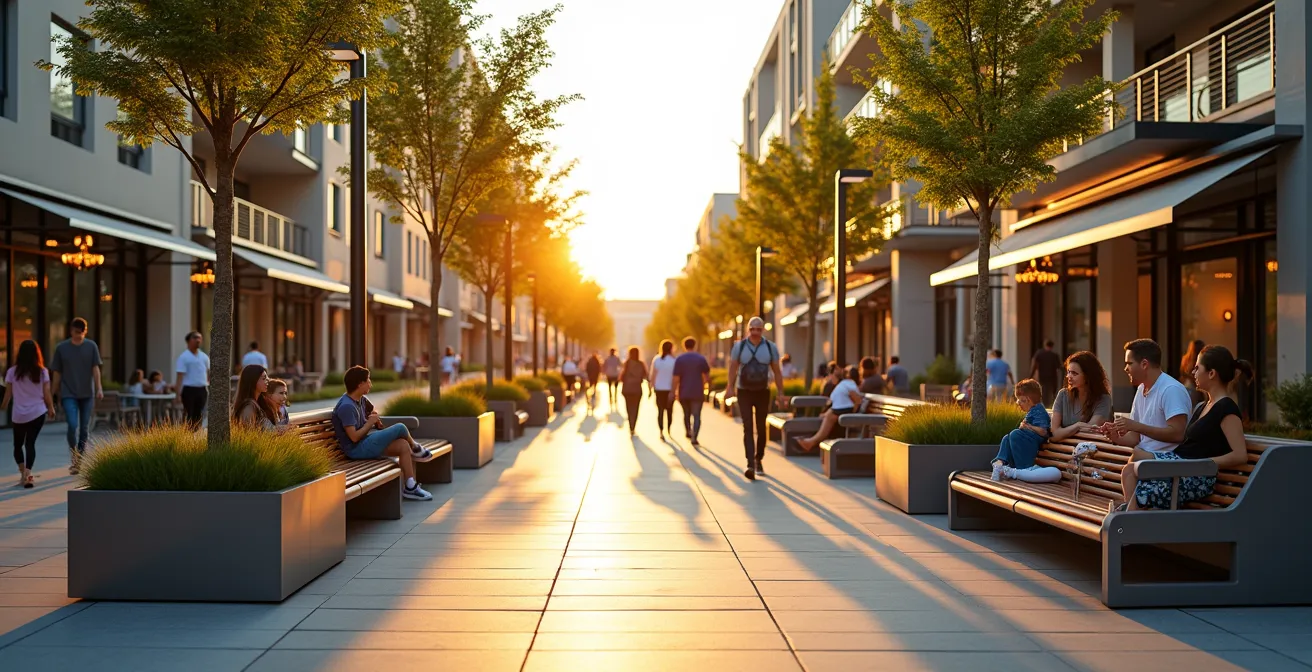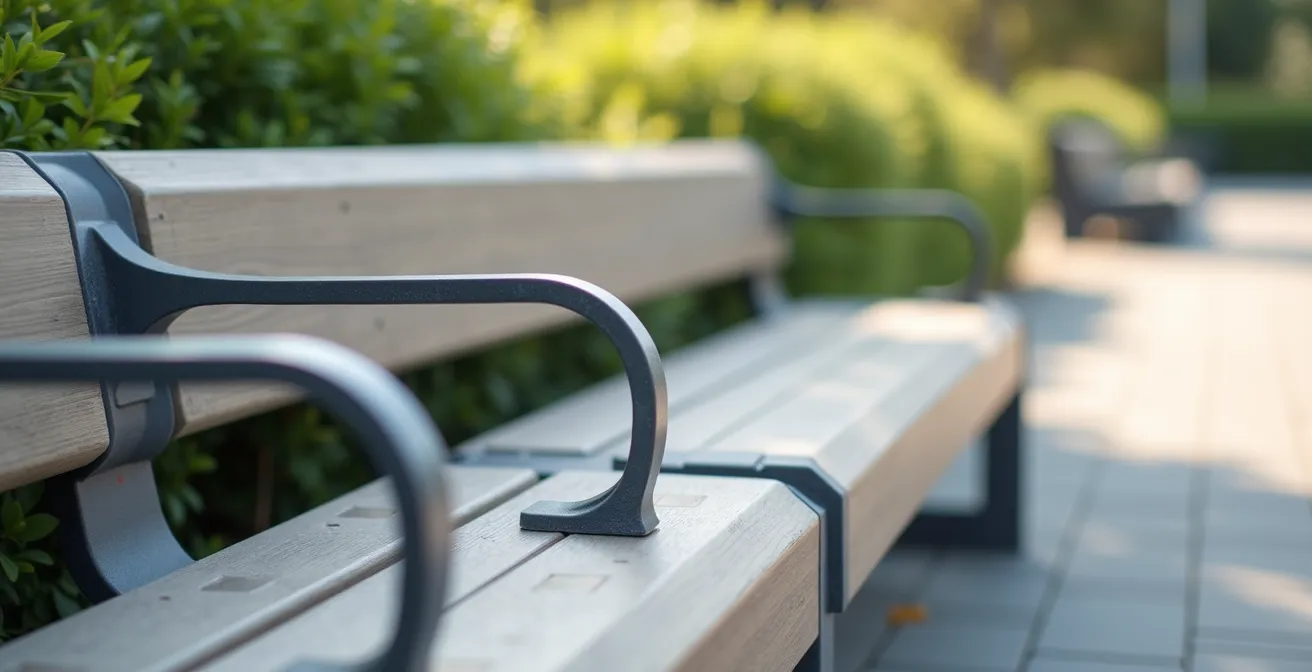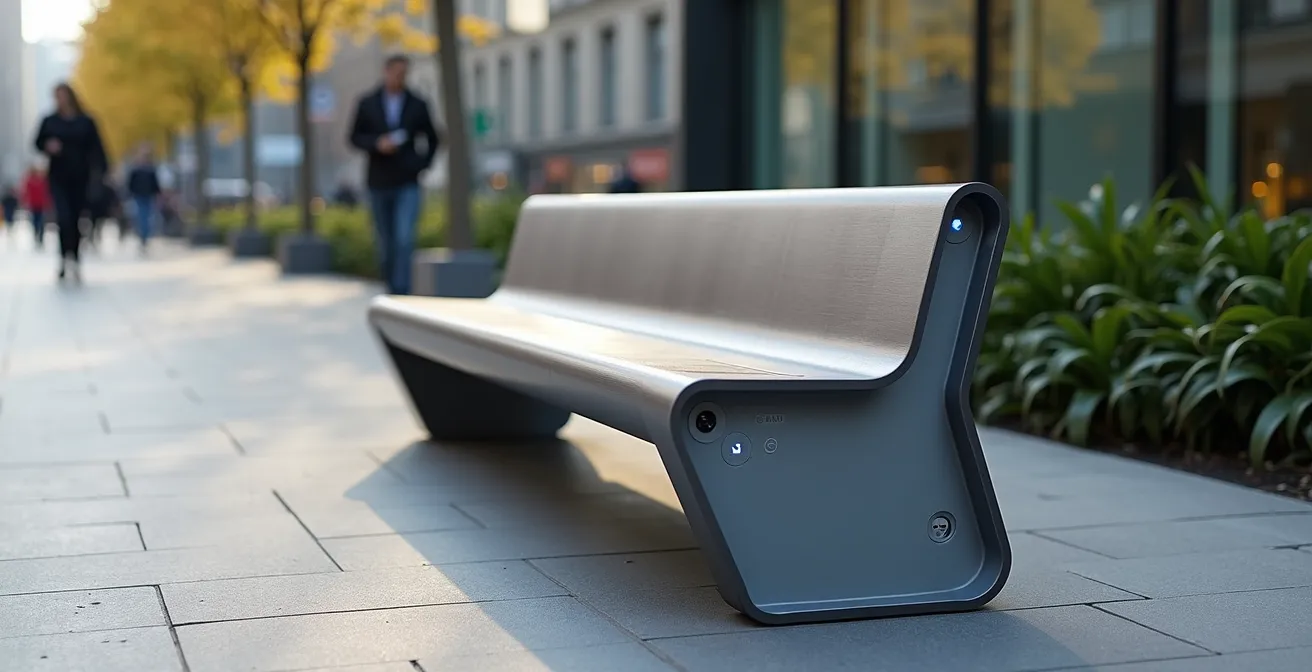
Street furniture is often perceived as a passive element of the urban landscape—utilitarian benches, bins, and lights that punctuate our public spaces. This view, however, overlooks its profound and active role in shaping the very DNA of a city. Far from being mere accessories, these installations are a sophisticated system capable of orchestrating economic vitality, influencing social equity, and proactively enhancing public safety. The true value is unlocked when we see the role of Street furniture not as isolated objects, but as a network of functional, intelligent, and psychological touchpoints that define urban life.
By moving beyond generic amenities, urban planners can leverage these elements to transform transient spaces into thriving destinations. This deeper approach reveals how a simple bench can foster community, a smart light pole can gather critical environmental data, and a strategically placed planter can deter crime. It’s an interconnected ecosystem where design directly translates into measurable economic and social returns, creating cities that are not only safer and more beautiful but also more resilient and inclusive for all their inhabitants.
The Urban Blueprint in 4 Key Insights
- Economic Engine: Well-designed furniture increases visitor dwell time, boosts local retail spending, and can elevate property values.
- Social Connector: Inclusive and thoughtfully arranged furniture encourages positive social interaction and ensures public spaces are accessible to everyone.
- Data Hub: Smart furniture equipped with sensors provides real-time data on everything from air quality to foot traffic, enabling smarter city management.
- Safety Architect: Strategic placement and design, guided by CPTED principles, actively deter crime and enhance the perception of safety.
From civic amenities to economic xatalysts: quantifying the commercial uplift of strategic street furniture
Strategic investment in street furniture transcends simple civic improvement; it is a direct driver of economic growth. Well-designed seating areas in commercial districts, for instance, invite pedestrians to linger longer. This increased “dwell time” directly correlates with higher consumer spending, as a brief stop can easily turn into a purchase at a local shop or café. The global market expansion reflecting increased municipal investment, projected to reach USD 14.68 billion by 2034, underscores the growing recognition of this economic potential.
This concept is central to “placemaking,” an approach that uses unique and aesthetically pleasing furniture to transform a simple street into a destination. By creating a distinct sense of place, cities attract more foot traffic, which is the lifeblood of local businesses. This increased activity generates both direct and indirect economic benefits. While retailers see immediate returns, property values in areas with high-quality, well-maintained public spaces often rise, enhancing the municipal tax base and attracting further investment.
Flint Farmers’ Market Downtown Revitalization Impact
The Flint Farmers’ Market served as a catalyst for downtown economic revival, supporting almost 50 small businesses while providing below-market rent at $35 per day for vendors. The market’s relocation to downtown created unprecedented opportunities for underserved entrepreneurs, with commercial kitchens and entrepreneurship training helping vendors transition from informal to formal business operations along Main Street. ( Source)
Various market analyses highlight this consistent growth, although estimates vary. Below is a comparison of projections from several leading research firms, all pointing toward a robust and expanding market for street furniture.
| Research Firm | 2024 Market Size | 2030+ Projection | CAGR |
|---|---|---|---|
| GM Insights | USD 5.6 billion | 2025-2034 period | 6.7% |
| Precedence Research | USD 10.21 billion | USD 14.68 billion by 2034 | 3.70% |
| Market Research Future | USD 10.2 billion | USD 15 billion by 2035 | 3.61% |
| Verified Market Reports | USD 68.3 billion | USD 95.6 billion by 2033 | 4.5% |
To quantify these returns, municipalities can adopt a structured approach. A clear methodology allows cities to measure the tangible benefits of their investments, turning anecdotal success into hard data for future planning.
Checklist for measuring economic impact
- Step 1: Establish baseline measurements of footfall, dwell time, and local business revenue before furniture installation
- Step 2: Monitor pedestrian flow patterns and sitting behavior using systematic observation methods
- Step 3: Survey local businesses quarterly on customer volume, average transaction value, and perceived area attractiveness
- Step 4: Track property values and rental rates within 200-meter radius of furniture installations
- Step 5: Conduct cost-benefit analysis comparing infrastructure investment to measurable economic returns
- Step 6: Document indirect benefits such as reduced crime, improved public health, and enhanced community cohesion
The unseen influence: how furniture design shapes public behavior and social equity
Beyond aesthetics, the design of street furniture has a profound, often unseen, influence on public behavior and social equity. While conversations often focus on “hostile architecture” designed to deter certain uses, a positive design approach actively encourages community engagement. Features like modular seating or benches with moveable components can foster spontaneous social interaction, turning a passive space into a dynamic social hub. As research from Berlin shows, design features are a primary determinant of how public spaces are used, with comfortable and well-placed seating becoming social catalysts while poorly designed areas remain empty.
The materials, colors, and forms used in furniture also carry psychological weight, shaping perceptions of safety and belonging. Thoughtful, inclusive design is critical for ensuring that public spaces are accessible to all. This means considering the needs of diverse populations—from benches with armrests and varied seating heights for the elderly and people with mobility challenges to ensuring clear paths for wheelchair users. This commitment to inclusive urban design for community wellbeing ensures that everyone feels welcome and can fully participate in public life.
The image below showcases an ergonomic bench designed with inclusivity at its core. Features such as supportive armrests, varied seat heights, and clear adjacent space for wheelchair access demonstrate how thoughtful design can accommodate a wide range of users, making public spaces truly public.

Analyzing the impact of these design choices reveals a clear contrast. Spaces with community-fostering furniture become vibrant and interactive, whereas those designed for pure transience often feel sterile and disconnected. The social dynamics of a space are not accidental; they are a direct result of the design cues provided by its furniture.
The configuration of seating has a measurable impact on social outcomes. Different arrangements can either encourage or inhibit interaction, directly affecting how long people stay and how they engage with one another.
| Furniture Configuration | Social Interaction Level | Group Formation Rate | Dwell Time Average |
|---|---|---|---|
| Moveable modular seating | High | 73% increase | 45+ minutes |
| Fixed linear benches | Medium | Standard baseline | 15-20 minutes |
| Individual scattered chairs | Low | 23% below baseline | 8-12 minutes |
| Circular/curved arrangements | Very High | 89% increase | 60+ minutes |
Beyond connectivity: the next generation of smart furniture as urban data hubs
The evolution of street furniture is moving far beyond common smart features like Wi-Fi hotspots and charging ports. The next generation is emerging as a network of urban data hubs. By embedding integrated sensors, this furniture can collect invaluable environmental data in real-time, including air quality, noise levels, and temperature. This hyperlocal information empowers city managers to make more responsive and efficient decisions.
This data-driven approach allows for dynamic city management. For example, streetlights can adjust their brightness based on real-time pedestrian flow, or waste collection schedules can be optimized based on how full smart bins are, saving fuel and reducing operational costs. The potential extends to public safety, where smart furniture can become an integrated part of a city’s emergency response system, broadcasting public information, displaying alerts, or even serving as resilient power sources during an outage.
What is smart street furniture?
Smart street furniture is public equipment enhanced with technologies like IoT sensors, Wi-Fi, and solar panels. It provides services like device charging while collecting real-time data on environmental conditions and public space usage to help cities operate more efficiently.
The image below illustrates a modern smart bench, seamlessly integrating technology into its design. Features like solar panels and discreet sensor housings show how functionality can be embedded without compromising aesthetics, turning a simple resting place into a powerful data collection tool.

However, this transformation also raises critical questions about privacy and data security. As public furniture becomes a data collection tool, clear policies are needed to govern how this information is collected, used, and protected. Establishing trust with the public is paramount to the successful implementation of these advanced urban systems.
Madrid’s Smart Urban Spaces IoT Integration Project
Madrid’s Smart Urban Spaces initiative integrates IoT sensors across urban facilities including street furniture, environmental sensors, energy meters, and traffic infrastructure. The project leverages interoperability of equipment to collect and analyze data from both installed sensors and citizen mobile phones, enabling real-time operational decisions and long-term urban planning based on accurate knowledge of citizen behavior and environmental conditions. ( Source)
Key takeaways
- Street furniture is an economic driver that enhances retail performance by increasing public dwell time and foot traffic.
- Inclusive and positive furniture design actively shapes social behavior, fostering community interaction and ensuring accessibility for all users.
- The future of urban management lies in smart furniture that collects environmental and usage data for more efficient city operations.
- Applying CPTED principles through furniture placement creates safer environments by enhancing visibility and guiding public movement.
Orchestrating safety: proactive crime prevention through environmental and furniture design
Thoughtfully designed and placed street furniture is a powerful tool for proactive crime prevention. This approach is a core component of Crime Prevention Through Environmental Design (CPTED), which uses the built environment to reduce opportunities for illicit activities. By focusing on furniture, planners can enhance natural surveillance, define territorial boundaries, and guide pedestrian flow to create safer public spaces.
Crime prevention through environmental design is an approach to problem-solving that considers environmental conditions and the opportunities they offer for crime or other unintended and undesirable behaviors. CPTED attempts to reduce or eliminate those opportunities by using elements of the environment to control access, provide opportunities to see and be seen, and define ownership and encourage the maintenance of territory.
– Diane Zahm, Problem-Oriented Policing Guide
The strategic arrangement of benches, planters, and bollards can eliminate potential hiding spots and create clear, observable pathways. Well-maintained, high-quality furniture also signals a high level of community care, reinforcing the “Broken Windows” theory—that visible signs of care and order can deter vandalism and minor crimes. Furthermore, integrated lighting in furniture, not just standalone poles, reduces shadowy areas and significantly increases the perceived safety of a space, with studies showing a notable 14% decrease in crime.
The randomized controlled experiment in New York City public housing showed remarkable crime reduction results. The installation of temporary lighting towers in 40 high-priority housing developments led to a 35% reduction in outdoor night-time crimes and approximately 4% decrease in total index crimes across the housing developments, with no evidence of crime displacement to nearby areas.
– New York City housing development lighting intervention results, Systematic Review
Applying CPTED principles through street furniture is a subtle yet highly effective way to engineer safer urban environments. The following table illustrates how different furniture applications align with core CPTED principles to produce specific safety outcomes.
| CPTED Principle | Street Furniture Application | Safety Outcome | Implementation Example |
|---|---|---|---|
| Natural Surveillance | Strategic bench placement | Increased visibility | Seating positioned to overlook pathways |
| Access Control | Bollards and planters | Controlled pedestrian flow | Define public vs private spaces |
| Territorial Reinforcement | Quality maintained furniture | Community ownership signals | Well-maintained benches indicate care |
| Activity Support | Integrated lighting systems | Attract legitimate users | Lit bollards create safe gathering areas |
By understanding these interconnected systems, urban planners and leaders can make more informed decisions. For deeper insights into how these strategies are being implemented on the ground, Explore local political landscapes.
Frequently asked questions on urban design
What types of environmental data can smart street furniture collect?
Smart street furniture equipped with IoT sensors can monitor air quality (PM2.5, NO₂, O₃, CO₂), water quality parameters, noise pollution levels, temperature, humidity, atmospheric pressure, and rainfall data.
How do IoT sensors in street furniture communicate data?
Environmental monitoring sensors use wireless protocols like LoRaWAN, NB-IoT, or cellular networks to transmit data to cloud platforms, enabling connectivity across hundreds of sensors without costly wiring infrastructure.
What are the main challenges of implementing smart street furniture networks?
Key challenges include high energy consumption requiring solar-assisted or energy-harvesting modules, potential electronic waste from large-scale deployments, data overload that can overwhelm legacy IT systems, and significant implementation costs for custom IoT solutions.
How can smart street furniture integrate with existing city systems?
Smart furniture can embed sensors into existing infrastructure like lampposts and benches, use multi-sensor hubs to reduce urban clutter, and integrate with environmental sensor analytics platforms for automated quality control and seamless network integration.